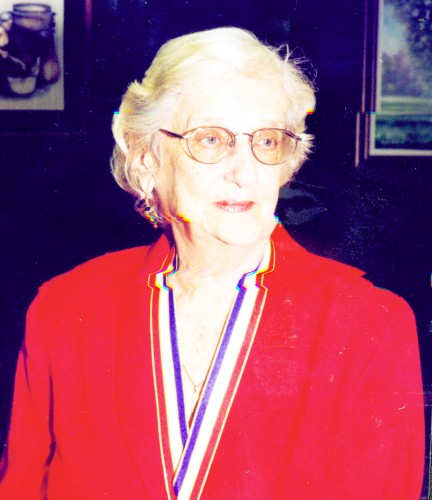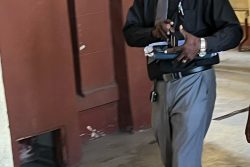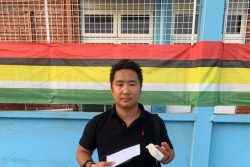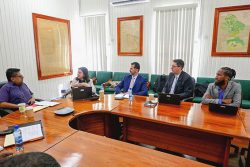Former President Mrs Janet Jagan passed away this morning at the Georgetown Hospital. She was 88 and had been ailing for sometime. Funeral arrangements are to await the arrival of her daughter, Nadira Jagan-Brancier. GINA said that President Bharrat Jagdeo who is currently in the Middle East on a series of visits will be returning home immediately.

Mrs Jagan, who was conferred with the Order of Excellence, served as President from December 19, 1997 to August 11, 1999. Women’s rights activist, journalist and part of the quartet of the Political Affairs Committee that led to the formation of the PPP in 1950, Mrs Jagan decided to contest for the Presidency following the death of her husband, President Cheddi Jagan in March of 1997.
Following his funeral Mrs Jagan had said that before he passed away he had told her that he wanted her to continue his work and she agreed to follow his wishes. This saw her being sworn in as Prime Minister of Guyana and first Vice-President on March 17, 1997.
For the scheduled elections that year she was chosen as the party’s Presidential candidate and this led to the creation of the so-called `A’ team which would later pave the way for President Bharrat Jagdeo to accede to the Presidency. It was announced then that if anything were to happen to her she would be replaced by the representative of the party, Jagdeo, while Prime Minister Sam Hinds, representing the Civic portion of the ticket, would remain in the PM’s position. This resulted in the so-called step-up, step down mechanism and Jagdeo became President in 1999. She triumphed in a highly controversial election and was sworn-in at a private ceremony attended by only a few persons amid reports that there was going to be a legal attempt to stop her swearing in. This was indeed the case as at the public ceremony that followed at State House, High Court marshals attempted to serve an order which would stop the swearing in. It led to the controversial incident in which she tossed the document disdainfully over her shoulder after it had been served on her. She would later explain that she meant no disrespect to the courts but had been moved to do this by what she felt had been decades of injustice meted out to her, her late husband, the PPP and their supporters. It was the type of action her supporters said typified the fighter in her.
Mrs Jagan’s period as President was marred by political unrest over the election results and the manner in which she was sworn in. The protests led mainly by the People’s National Congress resulted in the famous Herdmanston Accord of January 17, 1998 brokered by Caricom statesmen including Sir Shridath Ramphal which saw her agreeing to cut the term of office by two years and agreeing to other things. Unrest continued in various forms, with the PNC remaining out of Parliament and this led to the St Lucia Statement of July 2, 1998 in Castries, St Lucia where she shook hands with PNC Leader Desmond Hoyte on other commitments.
Mrs Jagan’s Presidency was in large part defined by the paralyzing public service strike in 1999 which spawned a crisis and sapped her energy.
In announcing her resignation on August 8, 1999 Mrs Jagan said “I considered at length and consulted close colleagues on the question of my continuing in office as President. It is now my firm and studied conclusion that I can no longer offer to the nation the vigorous and strong leadership that I had sought to provide during my 20 months as the lawfully and duly elected President of the Republic of Guyana. I therefore wish to announce that I intend to resign my position as President and to fulfil the promise I made during the 1997 election campaign”.
Prior to her resignation she had fallen ill and had had to be hospitalised here.
Analysts have contended that Mrs Jagan did not make the wisest decision in contesting for the Presidency as she was not seen as a candidate of conciliation but a hardliner with a history of confrontational politics. It was felt that the Presidential candidate should be someone else who could bridge divisions with the opposition and be a candidate of compromise. Others felt that the reason she agreed to be candidate was to avoid a divisive bare-knuckles fight in the PPP to succeed President Jagan as there was no clear choice.
After her resignation, Mrs Jagan continued to be in the public eye playing an integral part in the preservation of her husband’s memory and legacy and being a patron of the arts. She showed up last week at a lecture in memory of Dr Jagan.
In a statement this morning, the People’s Progressive Party (PPP) said
“Mrs. Jagan was in the leadership of the Party from the very beginning and served on the Central and Executive Committees until her death. She was also the General Secretary of the PPP from 1950-1970 and was succeeded by the late Dr. Cheddi Jagan.
“For many years she edited the Mirror newspapers particularly through the difficult 70’s and 80’s period. She was also the editor of the Thunder at the time of her death.
“Mrs. Jagan made a tremendous contribution to our Party and served the nation in several capacities, including being the first woman Town Councillor, first woman Deputy Speaker and among the first women in Parliament. She also served as Minister of Labour, Health and Housing and Minister of Home Affairs. She served as Prime Minister and President of the Republic.”
Typical of the views of many of her supporters was this comment posted on SN’s website yesterday “Late Mrs. Janet Jagan was a woman of indomitable will, unshakeable determination, perseverance and patience. Her contributions to the political landscape of Guyana will be remembered and revered as long as the Berbice, Demerara and Essequibo Rivers continue to flow. Like the Late President Dr. Cheddi Jagan their lives will continue to influence young politicians too in Guyana. A journey well travelled that felt no weariness for the betterment of the Guyanese people.”
Mrs Jagan was born on October 20, 1920 in Chicago, Illnois and married Dr Jagan on August 5, 1943. She was fervently committed to the marxist/communist ideology and was believed to have played an influential role in Dr Jagan’s early political development.
She came to British Guiana with him in December 1943 and worked for 10 years as a dental nurse in Dr Jagan’s clinic. She became immediately involved in the labour struggle and as a member of the first ever union in the colony, the British Guiana Labour Union. She was also the co-founder of the Political Affairs Committee. Mrs Jagan was elected General Secretary of the PPP in 1950 and served in that post until 1970. She was a founder of the Women’s Progressive Organisation and became the first elected woman to the Georgetown city council. She was later one of three women to enter the House of Assembly as a representative of the Essequibo Constituency.
Following the suspension of the constitution and the ousting of the government, Mrs Jagan was jailed for six months in 1955 and restricted to Georgetown after her release. When the PPP was returned to power in the 1957 elections she was appointed Minister of Labour, Health and Housing – one of her famous posts. In 1963 she became Minister of Home Affairs but resigned a year later over incidents of violence in Wismar.
She became a member of the Elections Commission in 1967 and played an active role in the opposition years during which she played a significant role in Parliament.
After the party’s triumph at the 1992 election, Mrs Jagan served for three months as the country’s ambassador to the United Nations.
She leaves to mourn her son, Dr Cheddi Jagan Jnr, daughter Nadira Jagan-Brancier, five grandchildren and many other relatives.








